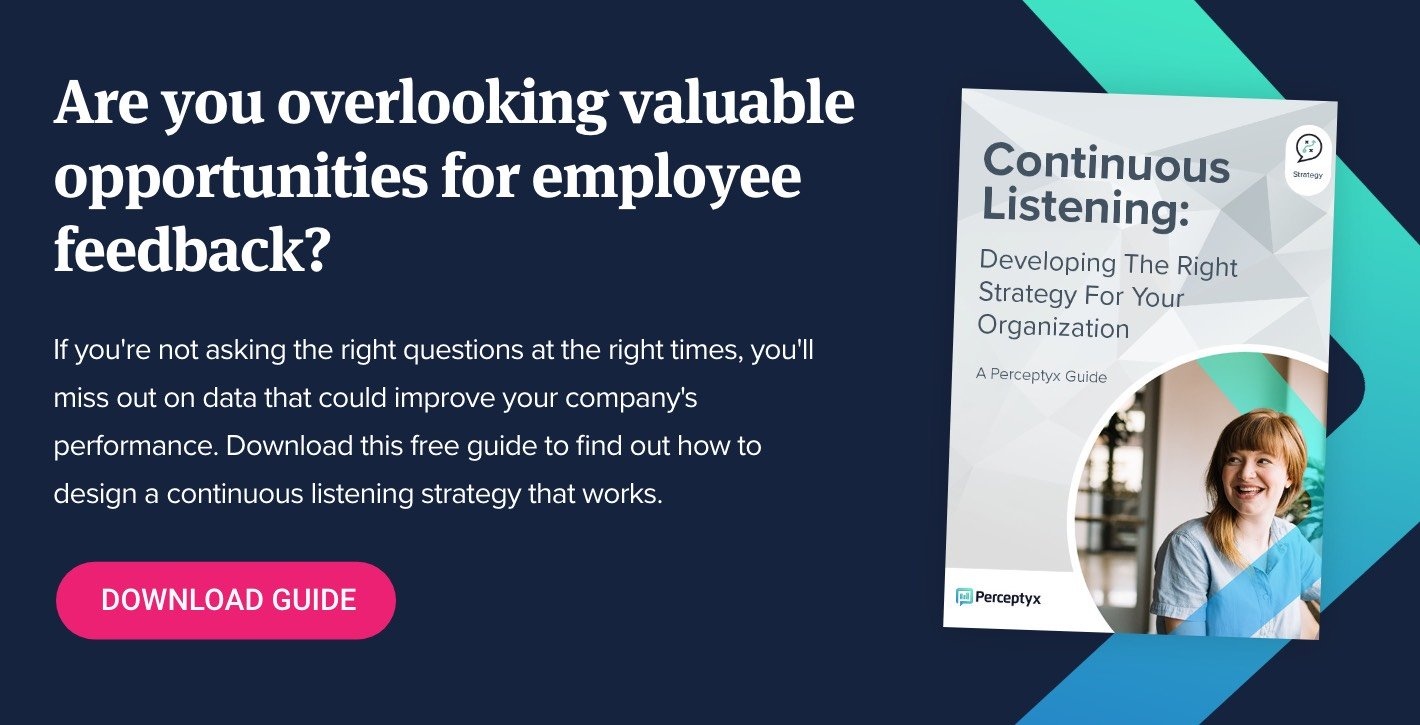And Im Continuously Listening to Baby Come Back
In the last chapter we discussed the shortcomings of relying on pulse surveys alone. Annual census surveys provide a breadth and depth of data, offering insights that cannot be gleaned from constant pulse surveys. But this does not mean that the annual employee engagement survey is the end-all and be-all, either. As noted in the first chapter, candidate and onboarding experiences also provide good opportunities for feedback, and there are other events in the employee journey where important data can be gathered as well. Taken together, there are many approaches to employee listening, each offering pros and cons if used in isolation. However, when backed by an overarching continuous listening strategy, they can offer a powerful and complementary approach to understanding the employee experience. For that reason it is important to consider the total employee experience, and optimize a listening strategy that gets the insights needed at the right time. Such insights are captured during the "moments that matter" for an employee - which is defined as "events that have a major impact on how people perceive and respond to the total employee experience." Such events have a substantial impact on engagement, productivity, performance, and retention. Your continuous listening strategy should describe to leaders how you will be able to provide stakeholders with the insights needed to remove the barriers of engagement, across the total employee journey. Just as businesses differ in their purpose, organization, and culture, measuring employee engagement is not a one-size-fits-all proposition which can be captured with one annual survey or multiple pulse surveys of small groups. It is a consolidated approach to asking the right questions, at the right time, using technology and reporting to pinpoint ways to enhance how employees experience the organization. Collecting information at the right time requires that the organization understands the moments that matter for collecting feedback. With a range of different methods available, this important step can often be overlooked. Moments that matter can include, but are not limited to: While the above list represents some pretty standard "moments that matter" it is important that businesses take a more agile approach. The list above is not exhaustive; there can be other events where a continuous listening strategy is important for capturing insights. These can include mergers, relocation of offices or facilities, adoption of new procedures or new technology, or other events with significant impact on employees' daily experience on the job, as with the COVID-19 pandemic. In all these instances, timing is critical; feedback must be captured during the period when changes are being implemented or immediately following to remove the barriers that prevent people being successful at work. The entire reason for listening, of course, is to inform dialogue and action. There is no point in running a survey just to observe and report the numbers. Listening and responding with appropriate action during those moments that matter is crucial because they are the events most likely to cause stress and disengagement. Searching for a job, interviewing, starting a new job or position, or figuring out where you fit into the picture in a reorganization are all stressful events. Collecting feedback and taking action during these critical moments allows leaders to tailor responses to mitigate the stress of change, reassure employees, and generally ease transitions to help employees see the way forward to a better experience. As the saying goes, in business, the only constant is change. Perceptyx deploys a powerful people analytics platform to capture perceptions of events that loom large in the employee experience—the transitions and changes—as well as feelings about the day-to-day routine and long-term direction of the business. Contact us today to see how we can help inform continuous dialogue in your company so you can see what matters most to your employees. Chapter 3
One major shortcoming for many organizations is that they choose an approach first before really understanding the insights they need over the total employee experience. The allure of the latest and greatest pulsing technology can sometime mean that companies embark on one approach (e.g., an always listening weekly survey), only to realize that it fails to provide a complete picture of the total employee experience. Such an approach often means that the return on investment is lost, and HR's credibility suffers through not being able to provide insights and answers to business leaders when they need them.Click here to take this entire, 35-page playbook with you.
Continuous Listening Captures The Moments That Matter
Continuous Listening Informs Dialogue and Action
Need a partner to help mold a continuous listening strategy around the moments that matter most to your employees?

Source: https://blog.perceptyx.com/capture-moments-that-matter-continuous-listening
0 Response to "And Im Continuously Listening to Baby Come Back"
Post a Comment